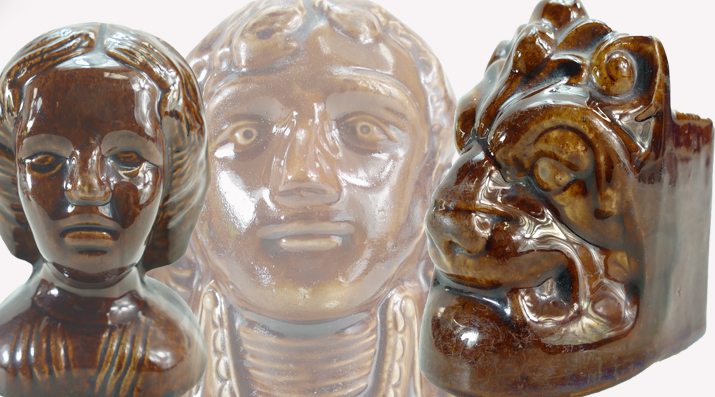
CERAMIC FURNITURE RESTS
Potteries Auctions have received approximately 160 furniture rests for our next Antiques, Rare Pottery & Fine Art Auction to be held on 14th July 2018.
Ceramic furniture rests were made in large numbers in Staffordshire, the North of England and Scotland in the late 18th Century, early 19th Century. Evidence of dates of manufacture is sparse. There is, however, mention by Llewellynn Jewitt in 1883, that ‘chest of drawers’ feet’ were being made at the Sneyd Factory, Burslem. A photograph taken at Hayes Pottery, Buckley, North Wales in about 1910 shows the manufacture of brown glazed rests, and an entry in the 1876 catalogue of the Museum of Practicle Geology of a brown glazed woman’s head rest, are a few of the earliest dates of manufacture mentioned.
Very little literature has been written about these rests and this is surprising, given that they were made in large quantities and in a variety of styles. Some were very decorative and must have been used extensively. Fortunately, we have some information from a book written by Peter Garland based on his collection which was built up over 40 years.

The furniture rests fall mainly into three broad categories, ‘platform rests’, ‘block rests’ and ‘castor rests’.
Platform Rests have an image or other decoration at the front and a platform at the back. The Platform rests were made in polychrome and monochrome and depict people, real and mythical, animals and other forms of decoration such as baskets of fruit or flowers.

The images are generally depicted in three-dimensional form but some platform rests have a substantially flat front showing the image as a raised silhouette.
The common forms of monochrome platform rests are the brown ‘treacle’ glaze lions and female heads.
Platform rests are usually made of earthenware, although some of the larger and more robust ones were made of stoneware. The platforms at the back are generally flat, often with a slight indentation at the centre and a rim around the edge. Many of the platforms also have scoring.

Block Rests are the second most commonly seen type of ceramic furniture rest. They are shaped like a block with flat tops and a square or rectangular horizontal cross section. Usually bearing silhouettes of people or animals or floral decoration and normally polychrome but are also found in blue and white pottery and brown stoneware.
The flat tops usually have a rim around the outside, scoring and sometimes an indentation in the centre.
One of the four sides of the block rests have an elaborate decoration, (intended to face outwards), the back often had no decoration.

Castor rests are the third type of ceramic furniture rest and has a round horizontal cross section and a baluster or diabolo form. The most common castor rest has a central indentation to receive the leg of the furniture and a raised rim.
Most castor rests are made of brown ‘treacle’ glazed earthenware and with red and yellow colouring.
Castor rests are known to have been made at a number of potteries until the early part of the 20th Century.

Glass piano rests came later to be used under many types of furniture, however, the early examples were intended for pianos, glass being a good conductor of sound which makes the notes more resonant.
The first reference in 1859 mentions a ‘pianoforte insulator’ objects registered from the 1870s until the end of the century were also called, less glamorously, ‘piano feet’ or ‘piano stands’, ‘rests’.
Take a look at some of the furniture rests that we will have for auction in July 2018, there are some very interesting examples which would compliment any collection of antiques.

